| URLs in this document have been updated. Links enclosed in {curly brackets} have been changed. If a replacement link was located, the new URL was added and the link is active; if a new site could not be identified, the broken link was removed. |
The 2005 Continuing Education Survey: What Science Librarians Want to Know
Life Sciences and Advanced Writing Librarian
Brigham Young University
Provo, Utah
betsy_spackman@byu.edu
Terri Freedman
Head, Collier Science Library
Bryn Mawr College
Bryn Mawr, Pennsylvania
tfreedma@brynmawr.edu
Camila Gabaldón
Collection Development Librarian
Western Oregon University
Monmouth, Oregon
gabaldonc@wou.edu
Virginia Baldwin
Head of the Engineering Library
University of Nebraska-Lincoln
Lincoln, Nebraska
vbaldwin2@unl.edu
Jill Powell
Engineering Research Services Librarian
Cornell University
Ithaca, New York
jhp1@cornell.edu
Abstract
The biennial STS continuing education survey was conducted at the end of 2005, in collaboration with two other organizations of science librarians. The top continuing education needs of science librarians include new technologies, professional development and keeping current, institutional repositories/digital archives, promoting science information literacy, collaboration between faculty and librarians, and finding free high-quality online data. This paper describes the process of developing and administering the survey and discusses the survey results.
Introduction
The primary charge of the Association of College and Research Libraries (ACRL) Science and Technology Section (STS) Continuing Education Committee is to conduct a biennial survey of the STS membership to determine continuing education needs. These results are presented to STS leadership and are intended to guide upcoming programming choices. For the 2005 survey, STS collaborated with two other organizations, the Engineering Libraries Division of the American Society for Engineering Education (ELD) and the Science-Technology Division of the Special Libraries Association (Sci-Tech). The survey was distributed to the approximately 1,100 subscribers of STS-L, the STS mailing list. Total STS membership is 1,609 and the mailing list is not limited to STS members, so it is difficult to determine the actual number of STS members reached. It was also distributed to the 253 members of ELD and the 591 members of Sci-Tech via their e-mail mailing lists.The STS Continuing Education Survey has its origins in the mid 1990s, when the first survey was distributed as a paper survey in STS Signal. Participants were asked to mail or fax their responses, which resulted in a very low response rate (Desai 2002). Since that time, the survey has moved to a web format, which is distributed via e-mail, using the discussion list STS-L. Initially, the change from a paper-based survey to a web-based survey resulted in an increased response rate, but over time the low response rate has remained problematic. In 2001, 144 responses to the survey were received and in 2003 the number of responses dropped to 91. The highest response rate in the survey's history occurred in 2004 when 254 total responses were received on the 2004 Hot Topics Survey which was also a collaboration with Sci-Tech and ELD. There were 133 total responses to the 2005 survey, which is a significant drop from the 2004 Hot Topics Survey.
History of Multi-Organization Collaboration
Actual collaboration among the three organizations -- STS, ELD, and Sci-Tech -- began in 2004 with the first Hot Topics Survey. Planning for the cross-organization survey began in 2003. During the planning years one person served as liaison between Sci-Tech and STS as well as between ELD and Sci-Tech, an asset in communicating with the three organizations.In June of 2003, at each of their annual meetings, all three organizations' governing bodies were presented with the idea of cooperating on a survey of their members' continuing education interests. Additional communication followed the meetings via e-mail. Originally the idea involved expanding the topics of the STS survey to include additional Sci-Tech and ELD topics of interest, coordinating the survey questions, and surveying the members separately. The results from the each of the three individual organizations could then be available as well as the combined results from all three.
The response to the idea at the Sci-Tech Board meeting was positive and included the suggestion of using SLA's Survey Monkey for Sci-Tech's portion of the survey. The idea was presented to the ELD Board in the form of a liaison report that included details of the Sci-Tech Board response to the proposal and was approved. It was thought that volunteers would be needed from the membership of both organizations to coordinate the survey.
The chair of the STS Continuing Education Committee decided that there was not enough lead time for participation in their Fall 2003 survey. At ALA Midwinter 2004 Continuing Education Committee members discussed some details of a collaborative survey. The consensus was to have one online survey instrument that would solicit responses from members of all three organizations with a mandatory question regarding affiliation(s) of the respondent. Results would be analyzed both separately and combined. The committee also discussed various online survey instruments. The survey would be distributed through the mailing lists of the three organizations. This eliminated the need for additional volunteers to produce separate surveys.
At ALA Annual 2004 Continuing Education Committee members decided to produce a smaller survey, to gauge interest in "hot topics," in the year between the biennial surveys, possibly using Survey Monkey (Christianson 2005). ELD and Sci-Tech would be invited to join in the survey with data analyzed as a whole and by demographic group with the affiliation question included. The survey would also be used to gauge attendance at the major conferences of the organizations. Attendance at the upcoming ACRL conference was included in the options. Several suggestions for hot topics were made by STS Council members and a list was compiled. The Sci-Tech and ELD liaison solicited additional hot topics from the governing boards of both organizations. Most of the submitted hot topics were included. Some were included in the hot topics survey while some were reserved for the 2005 annual survey. Of the topics from ELD that were added to the initial list of topics from the Continuing Education Committee, the following ranked high in the overall survey results for the 2004 Hot Topics Survey:
- Marketing and outreach
- Assessment and user surveying
- Usage statistics for collection development
- Development of an institutional repository
The Hot Topics Survey results were used by ELD members at the 2005 annual ASEE conference. At the ELD Special Interest Group (formerly Get Acquainted Session), the top 10 ELD topics from the survey were used to divide the attending members into round table discussion groups. In planning for the 2006 annual SLA conference Sci-Tech used the Hot Topics Survey results in the selection of the topic for their day-long, ticketed, Continuing Education course "Establishing an Institutional Repository" and also for their Contributed Papers session on "Open Access & Institutional Repositories." The title for both events related to the third ranked (for SLA conference attendees) topic "Development of a Digital Institutional Repository."
Literature Review
The issues that science and technology librarians are interested in are sometimes specific to their field, such as information literacy in the sciences, which has emerged as a top issue in each survey since 2001. Other issues have also made repeated appearances and the top three issues have been surprisingly consistent. In 2001 the top three issues were: instructional techniques and technologies, information literacy in the sciences and selection, management, and impact of electronic resources (Desai 2002). In 2003, liaison relations, information literacy in the sciences and the effect of electronic resources on library collections and services emerged (Christianson 2004).While some of the continuing education needs of science and technology librarians are specific to them as a group, other issues are of broader interest to the library community. During the same time period, other groups conducting continuing education surveys have found that their members were interested in many of the same topics identified in the STS surveys. The 2003 Continuing Education Survey of the Midwest Chapter of the Medical Library Association found that managing electronic resources and electronic subscriptions, both of which overlapped with topics mentioned in the 2003 STS survey, emerged near the top of their list (Jeuell 2004). In 2006, a survey of the PORTALS group found that using electronic resources and information literacy were among the top three topics their members were interested in (Wolf 2006). Also, electronic resources, emerging technologies and information literacy all appeared in the top 15 issues that Washington Library Association (WLA) members were interested in (WLA 2005). The Mountain Plains Library Association (MPLA) found that one of the largest areas of interest for their members was collection development, including the development of electronic collections. Many of their members also indicated that information literacy, particularly best practices in information literacy, mattered to them (MPLA 2001). Some of these results were from members who are similar in background and specialized information needs to STS, SLA Sci-Tech, and ELD, such as those in the Midwest Chapter of the Medical Library Association. Members of other groups were quite different, such as the PORTALS group, whose respondents were 41% school librarians and the MPLA survey, where almost 43% of respondents were public librarians (Wolf 2006; MPLA 2001). This may indicate that there is continuing overlap between the interests of science and technology librarians and the larger library community.
The recruitment of participants via mailing lists and online format for conducting the survey, while convenient and cost effective, may be related to the consistently low response rate to the STS Continuing Education Survey. While the paper-based survey of the mid-1990s had an even lower response rate than the most recent survey, there were several barriers to its successful completion, including the passive manner and lack of reminders with which participants were recruited (through a call in STS Signal) and the effort required to submit the survey (Desai 2001). In general, past studies indicate that paper-based surveys, especially those which include self-addressed, stamped envelopes, have a somewhat higher response rate than web-based surveys (Hayslett and Wildermuth 2004). This could, however, be changing. As Internet usage among all sectors of the population continues to rise, many of the traditional barriers to participating in web-based surveys may be less prohibitive.
Even the increase in Internet usage and the associated increase in the number and availability of online surveys may have a negative effect on response rates. Van Selm and Jankowski (2006) comment that regular users of the Internet are likely to be invited to participate in surveys "almost daily" indicating that regular users of the Internet (as librarians likely are) may decide to be selective about the surveys in which they choose to participate. Every type of survey has pitfalls associated with it and in many cases, including the Continuing Education Survey, the cost effectiveness of using a web-based survey versus paying for postage must be considered, especially when the group or individual conducting the survey may have access to an institutional subscription of a survey product or be able to use a "free" product.
Methods
The STS Continuing Education Committee was primarily responsible for the construction of the 2005 survey. The structure of the 2005 survey was built using the 2004 survey structure in the online survey-building software Survey Monkey. The open-ended question was moved to the front of the survey to avoid prompting respondents with the list of pre-selected topics. The list of pre-selected topics was developed by gathering from previous surveys and committee brainstorming for new ideas. Feedback was elicited from the Sci-Tech and ELD representatives until a final list of topics was created. Additional questions were constructed and vetted by both the STS Continuing Education Committee and the SLA and ELD representatives. STS leaders also provided input.The survey began with an open-ended question, asking respondents to list three topics in science librarianship they were interested in. Next, respondents marked their level of interest on 24 topics on a five-point Likert scale. Another open-ended box provided a space for respondents to list any other relevant topics. The survey then proceeded with questions on professional involvement, asking about professional organization membership and conference attendance. Survey respondents were asked where they live, by US state. Lastly, respondents were asked about professional development funding and preferred media for receiving continuing education. Respondents were given a range of funding, broken down in $500 increments from $0 to $3000. The question prompted respondents to consider funding for travel, workshop fees, conferences, or other continuing education expenses. On the question about preferred method for receiving continuing education, respondents were given options to select, which included credit courses-distance, credit courses-traditional, e-mail tutorials, in-person workshops, mentors, pre-conference workshops, teleconferences, web-based information, and other.
The committee elicited responses by distributing a link to the survey via e-mail to the mailing lists of the three sponsoring organizations (STS-L, SLA-ST-L, and ELD-L). The survey was open from October 31 to December 5, 2005.
Results and Discussion
Open-ended Topics of Greatest Interest
All of the responses provided in the open-ended boxes were analyzed and categorized. The topics of greatest interest fell into the following groupings:- New Technologies
- Professional Development & Keeping Current
- Institutional Repositories/Digital Archives
- Information Literacy/Instruction
- Scholarly Publishing/High Cost of Serials/Alternative Publishing Models
- Marketing & Outreach
The role that technology plays in our libraries and in our work was evident in a great number of the responses received. The topic that occurred most frequently involved the integration of new technologies into library instruction and services. RSS, podcasts, wikis, blogs, palms and cell phones were all mentioned and several people commented on their interest in future technologies and their applications. Some of the respondents wanted very practical information, such as how to set up an RSS feed or how to integrate library content into course management software. Others were interested in hearing accounts from librarians of successful projects they've undertaken using new technologies. Several respondents were concerned with the changing nature of new technologies and how to stay on top of new technology developments. It's clear that librarians are struggling with the question of where they should focus their time, energy and resources. "Do we need to jump on every bandwagon?" asked one respondent. The challenge of funding for these changing technologies was also mentioned.
Professional development, the second most popular topic, ties in closely with topic #1. Several people mentioned their interest in keeping up with new products and new technology developments. "Keeping current with the explosion of resources available" was an issue identified by many of the respondents. The recruitment and training of new science librarians also came up frequently. Topics relating to career development, such as how to prepare for advancement and develop managerial skills were also mentioned. One librarian wanted to know "how to keep up professionally and prepare for advancement in my career" while another wanted to know "how to get started and how to succeed in sci/tech librarianship." A number of people listed very specific tools, strategies, or technologies that they would like to learn more about. Topics mentioned include Geographic Information Systems, Google Scholar, PubChem, PubMed Central, searching and retrieval of patents and standards and "strategies for finding physical property data in handbooks and other reference materials."
A number of people were interested in finding out about institutional repositories or digital archives. This was the third most popular topic mentioned. Respondents wanted to know how to set up and manage an institutional repository as well as how to find and mine repositories that currently exist. Several people were interested in exploring the role of the library in setting up and maintaining institutional repositories, preserving data sets, etc. Respondents wanted to learn more about digitizing and archiving images, dissertations and theses, technical reports and standards, scientific data, and grey literature.
Pre-selected Topics
Table 1 shows the average ranking for pre-selected topics by all survey respondents. The top-ranked topics reflect interest in a wide-ranging number of issues, covering traditional duties of librarianship (such as instruction, liaison, collection development, and reference) in addition to the less traditional roles of marketing and advocacy. The top two topics, "promoting science information literacy" and "collaboration between faculty and librarians," seem particularly relevant to the work of academic science librarians, whereas the others are more universal, addressing concerns specific to science librarians or all librarians.
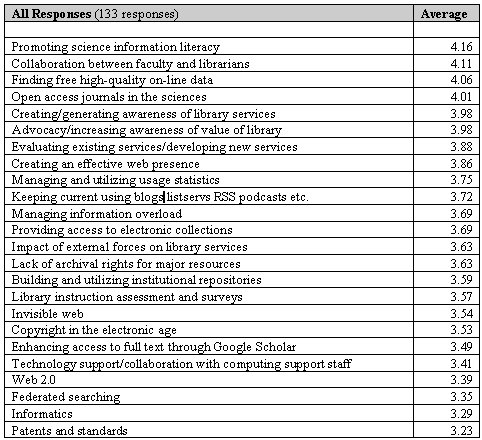
Table 1: Pre-selected Topic Rankings (All Respondents)
Rankings of pre-selected topics were filtered by conference attendance plans. (See Table 2 for a comparison of the top ten topics by conference attendance.) Conference attendance was chosen in lieu of organization membership because the survey results are intended in part to inform planning for conferences. The filtering revealed differences based on conference attendance; the three topics that resulted in the most significant differences were "evaluating existing services/developing new services," "lack of archival rights for major resources," and "creating an effective web presence."
SLA and ACRL attendees were more interested in "evaluating existing services/developing new services" than ALA and ASEE attendees. SLA attendees ranked this topic second, and ACRL attendees ranked it fourth. ALA and ASEE attendees ranked it eighth and ninth, respectively. ASEE and ACRL attendees were more interested in "lack of archival rights for major resources" than the other groups; ASEE attendees ranked this topic third, whereas ACRL attendees ranked it eighth. This topic was not in the top ten rankings for either ALA or SLA. Some disparity was also seen in the "creating an effective web presence" topic. ASEE and SLA attendees ranked this topic fourth and fifth respectively, whereas for ALA and ACRL attendees "creating an effective web presence" was ranked tenth.
Looking at the differences as a whole, SLA attendees are more interested in web topics than other respondents. "Finding free high quality online data" was ranked third, the highest ranking among the four groups. "Creating an effective web presence" was also ranked high among SLA attendees -- fifth, in comparison to tenth for those attending ALA Annual and ACRL. ASEE attendees ranked this topic fourth. Two topics related to the web were included in SLA attendees' top ten rankings that were not in any of the other conference attendees' lists. These topics are "building and utilizing institutional repositories" and "invisible web."
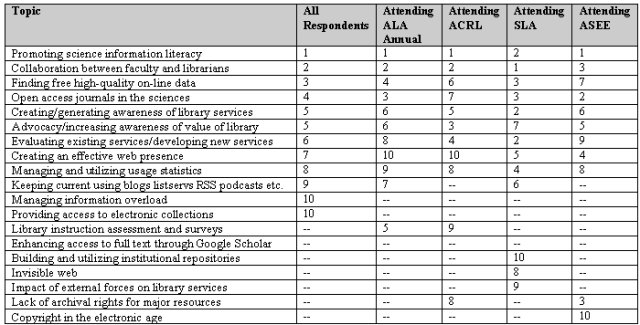
Table 2: Rankings of Top Ten Pre-selected Topics, by Conference Attendance
Each number corresponds to rank of importance for each group. Topics with identical averages have been given the same rank.
Additional Questions: Professional Involvement, Demographics, and Preferred Methods for Receiving Continuing Education
The survey included several questions after the pre-selected topics list; these asked about membership in professional organizations, conference attendance plans, geography, professional development funding, and preferred methods for receiving continuing education. Table 3 shows the distribution of membership in professional organizations among survey respondents. Approximately two thirds of survey respondents were members of both ALA and ACRL, with about a third reporting membership in ASEE ELD and Sci-Tech, respectively. A significant percentage of respondents, 42.2%, were members of other organizations, which included both other library or information organizations such as the American Society for Information Science and Technology (ASIST) and scientific organizations like the American Chemical Society. See the survey results at {http://www.ala.org/ala/mgrps/divs/acrl/about/sections/sts/continuinged/continuingedsurvey2005/profinvolvement.cfm} for the complete list.
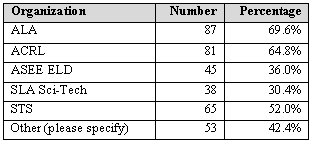
Table 3: Membership in Professional Organizations
Table 4 shows the correlation between membership in professional organizations and planned conference attendance. Of those respondents who are members of ASEE ELD and SLA Sci-Tech, approximately 70 percent plan on attending the ELD and SLA conferences. The percentage is 51 percent for ALA members and 32 percent for ACRL.
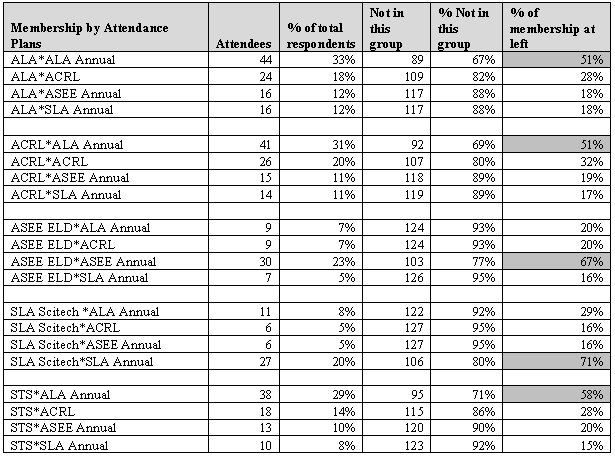
Table 4: Membership by Conference Attendance Plans
Table 5 shows the distribution of funding for professional development among survey respondents. The majority of survey respondents receive $500-$1,499 per year in professional development funding. Approximately 60% of respondents receive $500-$999 or $1,000-$1,499 per year in professional development funds. Approximately 10% receive less than $499 per year, whereas 17% receive over $1,500 in funding for professional development activities. Several respondents (12%) marked the other category, and their comments were quite varied, describing professional development situations unique to their institutions. No trends were evident from these comments.
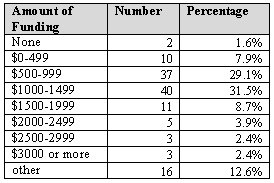
Table 5: Professional Development Funding
Figure 1 shows the distribution of preferred method for receiving continuing education. Respondents were asked to mark as many methods as they wanted. "In-person workshops" and "web-based information" were by far the most popular, with over 80 responses each. "Preconference workshops" and "teleconferences" were ranked next, with approximately 50 responses each. It seems that science librarians derive satisfaction from continuing education in a number of different formats, whether in person or remote. Please see {http://www.ala.org/ala/mgrps/divs/acrl/about/sections/sts/continuinged/continuingedsurvey2005/conted.cfm} for the full responses.
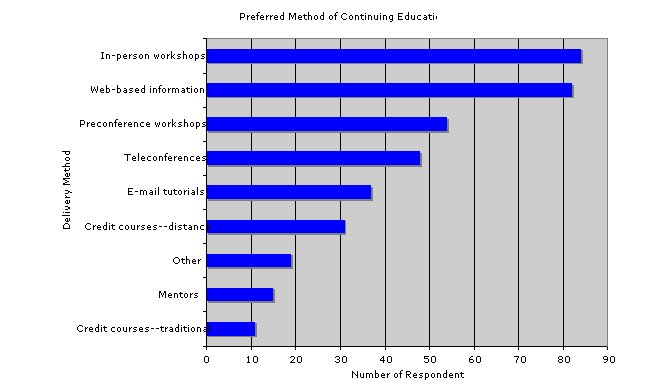
Figure 1: Preferred Method of Continuing Education
A total of 107 respondents provided data on the US state they live in, and the results indicate a broad geographic distribution. Sixteen respondents were from California, with an additional 10 from Pennsylvania. A total of 35 states were represented. The original intent for this question was to provide data that could be used by local librarians to provide continuing education opportunities. However, there were not enough respondents to produce useful data when filtered by state.
Comparison to Previous Surveys
A number of pre-selected topics on the 2005 survey were also included in the previous four surveys, which allows comparisons of important topics since 2001. See Table 6 for the number of pre-selected topics in each survey year. The continual top ranking of several topics lends particular importance to them. These topics are information literacy, open access journals, and liaison and collaboration with faculty.Information literacy in the sciences has been a top interest since 2001, when it was ranked first. Although information literacy was not included in the 2004 Hot Topics Survey, it was ranked second in the 2003 survey and first in the 2005 survey. The strong interest of science librarians in information literacy is confirmed by several trends. The Task Force on Information Literacy for Science and Technology was created in 2002 and recently saw the fruits of its labor in the ACRL approval of the new Information Literacy Standards for Science and Engineering /Technology. ACRL approved the standards at ALA Annual 2006 in New Orleans and published them on their {Standards and Guidelines web page}. Also at ALA Annual 2006, the new STS Information Literacy committee was approved. In 2004 the topic of information literacy in the sciences was highlighted in the STS Annual Program "Making Connections on Campus: Collaborative Approaches to Information Literacy in the Sciences."
The topic of open access journals debuted on the Hot Topics Survey in 2004, where it was ranked first. In 2005, it was ranked fourth. Although open access journals was not included as a topic in either 2001 or 2003, a related topic -- coping with the serials crisis -- was ranked fifth and eighth respectively. These top ten rankings illustrate that the issue is important to science librarians as a continuing education need.
Working with faculty is the third pre-selected topic that is of particular importance because of consistently high rankings in the surveys of the last five years. There were slight variations in wording between the surveys, but collaboration and liaison with faculty were consistent themes. In 2001 the topic was "effective liaison meetings," which was ranked fifth. In 2003, "improving liaison relationships with academic faculty" was ranked first, whereas in the 2004 Hot Topics Survey "collaborating with faculty on research or teaching" was ranked fifth. And in 2005, "collaboration between faculty and librarians" was ranked second on the pre-selected topics list.
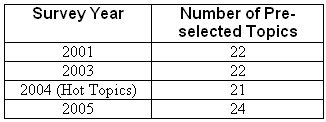
Table 6: Number of Pre-selected Topics
Implementation and Use of Survey
The survey was closed in early December 2005. Preliminary analysis was completed for ALA Midwinter in January 2006, and the results were distributed to committee chairs and STS leaders at STS Council for use in program planning. Results were then distributed to the ELD and SLA liaisons. In April 2006, the results were posted online to the STS web site and a link to the page was distributed via the mailing lists of the three participating organizations.The survey results were used in different ways by each organization. As stated earlier ELD used the results to develop topics for the Special Interest Group (formerly Get Acquainted Session) at the 2006 ASEE/ELD Annual Conference, and SLA primarily used the survey results to select topics for conference sessions and a continuing education course. In developing a continuing education course for the 2007 SLA Conference, Sci-Tech board members were asked to provide input via e-mail. The 2005 survey results were considered among the candidate topics. Specifically, the top four topics from all recipients were among those considered:
- Promoting science information literacy
- Collaboration between faculty and librarians
- Finding free high-quality online data
- Open access journals in the sciences
A high ranking topic for SLA conference attendees was "Keeping current using blogs mailing lists RSS podcasts etc." Comments from the New Technologies portion under the Open-ended Questions section of the 2005 survey were also considered:
- Library applications of new technologies (blogs, RSS, podcasts, wikis, etc.)
- Integrating new technologies into library instruction and services
- Using new technologies to help researchers keep current
- Using new technologies to communicate with the millennium generation
- Case studies of interesting projects involving new technologies
- RSS: how to set up
- Keeping up with technology developments
- Technical methods for integrating library content into course management software or portals
The options were ranked by board members and the two that came out on top and were submitted to the Professional Development Chair for the 2007 SLA conference were:
- Finding/Managing free high quality scientific data online/on the web.
- Integrating new technologies into science libraries/library instruction; using technology to help scientific researchers keep current.
Another potential future use for the survey results is to select conference sessions. The top-ranked topics have all been represented in recent conferences. Themed sessions are usually chosen based on members' interests, and the type of papers submitted. Program chairs can plan the conference to meet member needs, as delineated in the survey results. Often there are too many papers submitted to be accommodated, so having a top ten list is a good way to decide what to include.
Recommendations for the Next Survey
Based on the 2005 survey, several improvements may be appropriate for the 2007 survey. The number of respondents went down significantly from the 2004 Hot Topics Survey to the 2005 survey. The open-ended data wells at the beginning of the survey might have resulted in this decrease in the number of respondents -- busy librarians may have been deterred by the open-ended questions on the first page. The open-ended question was moved to the front in order to avoid bias in the results -- it was thought that the list of topics prompted respondents to list those topics again in the open-ended question. Moving the Likert scale and the pre-selected topics to the front page of the survey might increase the number of respondents.Additionally, respondents to the 2005 survey were asked to indicate which US state they lived in so that the responses could be analyzed by region. Future surveys should expand this to include Canadian and other international librarians.
Finally, the next survey should include more questions from previous biennial surveys. This would bring out trends across the years, and would allow for comparisons to be made between the surveys. Changes to the topics between surveys decrease the effectiveness of monitoring trends.
Suggested Web Sites:
2005 Continuing Education Survey Results:{http://www.ala.org/ala/mgrps/divs/acrl/about/sections/sts/continuinged/continuingedsurvey2005/index.cfm}
2004 Hot Topics Survey:
{http://web.archive.org/web/20060211145354/http://www.lib.auburn.edu/scitech/resguide/forestry/STSCESurvey2004b.htm}
2003 Continuing Education Survey Results:
{http://web.archive.org/web/20060211145348/http://www.lib.auburn.edu/scitech/resguide/forestry/STSSurvey2003.htm}
STS Continuing Education Committee:
{http://www.ala.org/acrl/sts/acr-stsce}
Special Libraries Association Science-Technology Division
{http://scitech.sla.org/}
American Society for Engineering Education Engineering Libraries Division
{http://depts.washington.edu/englib/eld/}
References
Christianson, M. 2004. The 2003 STS continuing education survey: Selected analyses of science librarians' interests. Issues in Science and Technology Librarianship 41. [Online]. Available: http://www.istl.org/04-fall/refereed.html [May 14, 2006].________. 2005. Hot Topics Survey: 2004, Collaborative Continuing Education Survey. STS Signal 20(1), 2 p. [Online]. Available: {http://www.ala.org/ala/mgrps/divs/acrl/about/sections/sts/publications/spring05.pdf} [August 7, 2006].
Desai, C.M. 2002 Continuing education needs of science and technology librarians: Results of the 2001 STS Continuing Education Committee Survey. Issues in Science and Technology Librarianship 34. [Online]. Available: http://www.istl.org/02-spring/article5.html [May 14, 2006].
Hayslett, M. M., & Wildemuth, B. M. 2004. Pixels or pencils? The relative effectiveness of Web-based versus paper surveys. Library & Information Science Research 26(1): 73-93.
Jeuell, C. 2004. Continuing education survey, 2003 -- Summary of results. Midwest Chapter, Medical Libraries Association. [Online]. Available: {http://midwestmla.org/education/surveyresults.htm} [June 15, 2006].
MPLA continuing education survey, 2001: Summary results. 2001. [Online]. Available: {http://www.mpla.us/documents/board-reports/old-committees/continuing-education/continuing-education-committee-report-2001-continuing-education-survey-executive-summary.pdf} [June 15, 2006].
Van Selm, M. & Jankowski, N.W. 2006. Conducting Online Surveys. Quality & Quantity 40 (3): 435-456.
WLA continuing education survey. 2005. [Online]. Available: {http://www.wla.org/training/cesurvey_05results.doc} [June 15, 2006].
Wolf, J. 2006. PORTALS continuing education online survey results. [Online]. Available: {http://web.archive.org/web/20070110035801/http://www.portals.org/LSTA/ResultsReport.pdf} [August 8, 2006].
| Previous | Contents | Next |
